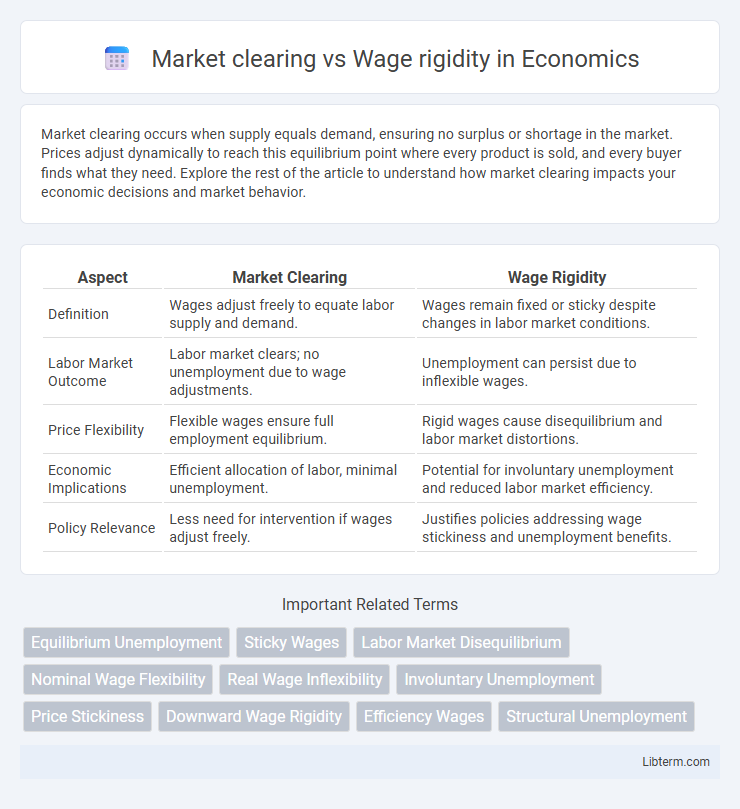Market clearing occurs when supply equals demand, ensuring no surplus or shortage in the market. Prices adjust dynamically to reach this equilibrium point where every product is sold, and every buyer finds what they need. Explore the rest of the article to understand how market clearing impacts your economic decisions and market behavior.
Table of Comparison
| Aspect | Market Clearing | Wage Rigidity |
|---|---|---|
| Definition | Wages adjust freely to equate labor supply and demand. | Wages remain fixed or sticky despite changes in labor market conditions. |
| Labor Market Outcome | Labor market clears; no unemployment due to wage adjustments. | Unemployment can persist due to inflexible wages. |
| Price Flexibility | Flexible wages ensure full employment equilibrium. | Rigid wages cause disequilibrium and labor market distortions. |
| Economic Implications | Efficient allocation of labor, minimal unemployment. | Potential for involuntary unemployment and reduced labor market efficiency. |
| Policy Relevance | Less need for intervention if wages adjust freely. | Justifies policies addressing wage stickiness and unemployment benefits. |
Introduction to Market Clearing and Wage Rigidity
Market clearing occurs when labor supply equals labor demand, resulting in equilibrium wages that balance job vacancies and workers seeking employment. Wage rigidity refers to the condition where wages do not adjust downward despite excess labor supply, causing unemployment to persist. Understanding the dynamics between market clearing and wage rigidity is essential for analyzing labor market efficiency and unemployment fluctuations.
Defining Market Clearing in Economics
Market clearing in economics occurs when supply equals demand, resulting in no excess goods or labor in the market. It assumes flexible prices and wages adjust instantly to balance quantity supplied and demanded, enabling efficient resource allocation. Wage rigidity disrupts this equilibrium by preventing wages from adjusting downward, leading to unemployment or labor surpluses.
Understanding Wage Rigidity
Wage rigidity refers to the resistance of wages to adjust downward despite changes in labor market conditions, often caused by factors such as long-term contracts, minimum wage laws, or social norms. Market clearing assumes flexible wages instantly balance labor supply and demand, yet empirical evidence shows wages tend to be sticky, leading to unemployment during economic downturns. Understanding wage rigidity is crucial for analyzing persistent unemployment and designing effective labor market policies.
Causes of Wage Rigidity
Wage rigidity often arises from long-term employment contracts, minimum wage laws, and labor union negotiations, which prevent wages from adjusting freely in response to market conditions. Efficiency wage theories also explain wage rigidity by suggesting that employers pay above-market wages to boost productivity and reduce turnover. These factors disrupt market clearing by keeping wages sticky downward, leading to unemployment when labor supply exceeds demand.
How Market Clearing Works in Labor Markets
Market clearing in labor markets occurs when the supply of labor equals the demand at an equilibrium wage rate, ensuring no excess unemployment or labor shortages. Wages adjust flexibly in response to shifts in labor supply or demand, facilitating optimal resource allocation and efficient matching of workers to jobs. This mechanism contrasts with wage rigidity, where wages remain sticky due to contracts or regulations, preventing labor markets from clearing effectively.
Effects of Wage Rigidity on Employment
Wage rigidity prevents labor markets from clearing by keeping wages above equilibrium levels, leading to excess labor supply and unemployment. This inflexibility causes firms to reduce hiring or lay off workers during economic downturns, exacerbating job losses. Empirical studies show that economies with higher wage rigidity experience prolonged unemployment durations and slower labor market adjustments.
Market Clearing vs Wage Rigidity: Key Differences
Market clearing assumes wages adjust freely to balance labor supply and demand, eliminating unemployment. Wage rigidity refers to fixed or sticky wages that prevent this adjustment, causing persistent unemployment or labor market imbalances. Key differences include wage flexibility, labor market equilibrium, and the responsiveness of employment levels to economic changes.
Real-World Examples and Case Studies
Market clearing assumptions often fail in real-world labor markets where wage rigidity prevents wages from adjusting to clear supply and demand. For instance, during the 2008 financial crisis, many firms maintained sticky nominal wages despite rising unemployment, as observed in the U.S. labor market, leading to prolonged jobless spells. Case studies from European economies, such as Spain and Italy, highlight how collective bargaining agreements and minimum wage laws contribute to wage rigidity, exacerbating unemployment during downturns.
Policy Implications and Recommendations
Market clearing models assume wages adjust freely to balance labor supply and demand, promoting full employment and efficient resource allocation. Wage rigidity, caused by factors like minimum wage laws, unions, or efficiency wages, can lead to unemployment and labor market inefficiencies. Policies should aim to enhance wage flexibility through targeted labor reforms, support retraining programs, and promote bargaining frameworks that balance worker protection with market responsiveness to reduce unemployment risks.
Conclusion: Balancing Flexibility and Stability
Market clearing promotes labor market flexibility by allowing wages to adjust to supply and demand, reducing unemployment. Wage rigidity provides income stability and consumer confidence by preventing sharp wage declines, but can lead to persistent unemployment. Balancing flexible wage adjustments with protections against excessive wage fluctuations is essential for optimizing both employment levels and economic stability.
Market clearing Infographic

 libterm.com
libterm.com